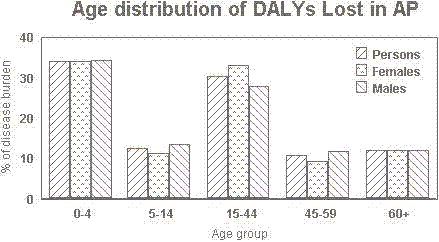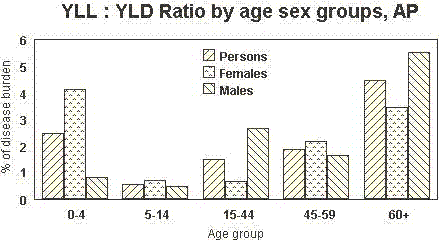| |
|
 |
| Institute of Health Systems |
|
|
|
|
|
|
|
 |
|
|
 |
|
 |
Home  Burden of Disease Burden of Disease APBOD Study Results and Important CoD Burden APBOD Study Results and Important CoD Burden |
| |
| AP Burden of Disease Study Results
and Important Causes of Disease Burden |
| |
 |
|
We present two estimates of disease burden in Andhra Pradesh. The two differ in the set of disability weights used for the health states. There are different schools of thought and preferences about the method of valuation to directly measure the subjective utility of different health states from individuals. Some believe that VAS tends to obtain a more severe valuation for milder health states, and think that TTO valuations are less biased. Although theoretical justifications for TTO valuations have been advanced, the belief appears to have been strengthened by its closeness to judgements by public health experts about disability weights for various health states.
Health state valuations are by definition individual preferences between different health states. So valuation by public health experts are indeed individual preferences of these professionals. A public health professional can hardly claim any expertise in valuation of health states, except for his / her own valuations. These professionals usually have better knowledge of different health states. In other words their expertise is in visualising description of health states and connecting a disease label to some description. In addition, people may attach some importance to personal preference of public health experts. Extending upon this willingness of people to defer to professional judgement, the expert rated disability weights can also be viewed as objective assignment of health state values. The disability weights used by the GBD96 study were derived from workshops mostly attended by medical and public health experts from different areas and are labelled expert rated disability weights. These disability weights can be considered as aggregated individual preferences from a convenience sample or as objective assignment of weights by public health experts, depending on one’s point of view. The expressions "expert rated" and "expert judgement" etc. are used here to mean valuation by public health experts.
The Andhra Pradesh Health State Valuation Study 1999, revealed that the community in Kondakkal village assigned consistently higher disability weights compared to the GBD96 weights. We have seen that part of the difference between APHSV99 community rated disability weights and GBD96 weights can be attributed to VAS. But another part of the difference appears to be real. If VAS is indeed generally scaling the disability weights upwards and more so for milder conditions, then it is in effect giving more weightage to disability component of the summary measure of population health status. In any case the disease burden estimate using VAS-based local measurement of disability weights can be viewed as a scenario giving relatively higher importance to disability component over premature mortality component. Policy makers can then reflect on the commonalties and differences between disease burden estimates based on local cause of death data and a conservative estimate of disability component using generally lower disability weights arrived at by experts, and VAS based measurements of disability weights from community studies. Here the set of disability weights obtained from community survey are referred as community rated disability weights.
Thus the two burden of disease estimates presented below use the (a) expert rated disability weights and (b) community rated disability weights, respectively. The community rated disability weights are generally higher than the expert rated disability weights, for corresponding health states. Hence the burden of disease estimate based on community rated disability weight is expected to emphasise disability component of the disease burden. Such estimates can be useful for planning of health care delivery capacity and types of health care delivery institutions. The expert rated disease burden estimates would show the mortality component of the disease burden more than the other estimate. Hence they can be used to plan for preventive programs and to set priorities for research. Some leading causes of burden may show up in all estimates. Such causes of disease burden found to be important from more than one perspective will naturally deserve greater attention and be prime objects of health policy. |
|
 |
 |
APBD estimates using expert rated disability weights:
Results presented in this section are based on general demographic estimates of mortality level and population, and causes of death in the state. Epidemiological estimates of incidence, age at onset and duration are taken from the Global Burden of Disease study 1996 (Murray and Lopez, 1996) for the India region. The GBD96 disability weights used by Murray and Lopez (1996) for the GBD study are maintained.
Rural-Urban distribution of disease burden in AP
The above figure shows the rural-urban distribution of disease burden in the state. About 79% of disease burden is estimated to be in the rural region. The rate of disease burden is also higher in the rural areas, where rate of loss is 300 DALYs / 1000 persons. In urban areas the rate of loss is 214 DALYs / 1000 persons. Distribution of DALYs and YLL : YLD ratio by age sex groups
   The figure about distribution of DALYs & YLL shows age-sex distribution of disease burden and the composition in terms of YLL : YLD ratios. A lot of disease burden is concentrated in infancy and early childhood. These are mostly due to premature mortality, as can be inferred from the high YLL to YLD ratio in this age group. Within the 0-4 year age group, girl infants and children are more vulnerable to death (YLL:YLD ratio = 4.14), whereas male infants and children live with disability (YLL to YLD ration = 0.83). In adult age group of 15 to 44, the situation is reversed. Among those who suffer, females tend to live with disability and males are more vulnerable to death.Ten leading causes of burden in rural and urban areas of the state is given in the immediate table. Six leading causes are common to both the areas. These are: (a) lower respiratory infections, (b) diarrhoea, (c) low birth weight, (d) ischaemic heart disease, (e) falls and (f) tuberculosis. Poor nutrition, lack of safe drinking water and sanitation are common risk factors for three of these, namely lower respiratory infection, diarrhoea, and low birth weight. Four of these (a, b, c, and f) are already included in various public health and disease control programs of the state. The results obtained here reinforces the desirability of those programs.
Leading causes of disease burden (DALY) in rural and urban areas of AP |
|---|
| Rural : Cause |
% |
Urban : Cause |
% |
| Lower Respiratory Infections | 8.4 | Falls | 6.91 |
| Diarrhoeal diseases | 6.94 | Low birth weight | 6.32 |
| Low birth weight | 6.8 | Lower Respiratory Infections | 5.98 |
| Ischaemic heart disease | 6.09 | Tuberculosis | 5.34 |
| Self-inflicted injury | 4.24 | Ischaemic heart disease | 3.77 |
| Tuberculosis | 4.1 | Fires | 3.47 |
| Cerebrovascular disease | 2.56 | Birth Asphyxia and birth trauma | 3.21 |
| Bacterial meningitis and meningococcaemia | 2.39 | Road accidents | 2.96 |
| Epilepsy | 2.24 | Unipolar major depression | 2.91 |
| Road accidents | 2.15 | | |
| Residual cause groups with % burden higher than last cause included above: |
| Other unintentional injuries | 5.83 | Other cardiac diseases | 3.72 |
| | | Other unintentional injuries | 3.68 |
|
 |
| |
|
|
|
|
|